

Terrestrial planet. Structure[edit] Solar terrestrial planets[edit] Dwarf planet. Pluto in approximate true colour based on Hubble Space Telescope albedo data A dwarf planet is an object the size of a planet (a planetary-mass object) but that is neither a planet nor a moon or other natural satellite.
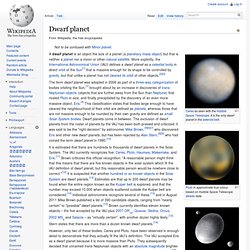
More explicitly, the International Astronomical Union (IAU) defines a dwarf planet as a celestial body in direct orbit of the Sun[1] that is massive enough for its shape to be controlled by gravity, but that unlike a planet has not cleared its orbit of other objects.[2][3] However, only two of these bodies, Ceres and Pluto, have been observed in enough detail to demonstrate that they actually fit the IAU's definition. The IAU accepted Eris as a dwarf planet because it is more massive than Pluto.
CH star. CH stars are particular type of carbon stars which are characterized by the presence of exceedingly strong CH absorption bands in their spectra.

They belong to the star population II, meaning they're metal poor and generally pretty middle-aged stars, and are underluminous compared to the classical C–N carbon stars. Many CH stars are known to be binaries, and it's reasonable to believe this is the case for all CH stars. Astrochemistry. Astrochemistry is the study of the abundance and reactions of chemical elements and molecules in the universe, and their interaction with radiation.
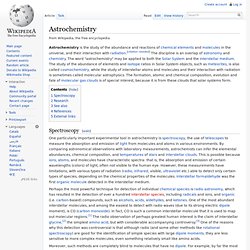
[citation needed] The discipline is an overlap of astronomy and chemistry. The word "astrochemistry" may be applied to both the Solar System and the interstellar medium. The study of the abundance of elements and isotope ratios in Solar System objects, such as meteorites, is also called cosmochemistry, while the study of interstellar atoms and molecules and their interaction with radiation is sometimes called molecular astrophysics. The formation, atomic and chemical composition, evolution and fate of molecular gas clouds is of special interest, because it is from these clouds that solar systems form. Primary Life Support System. A Portable Life Support System from the Apollo A7L suit, with its outer cover removed A Primary (or Portable or Personal) Life Support System (or /Subsystem) (PLSS), is a device connected to an astronaut or cosmonaut's spacesuit, which allows extra-vehicular activity with maximum freedom, independent of a spacecraft's life support system.
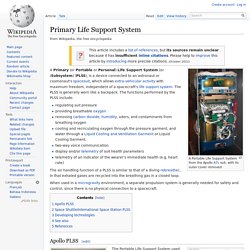
The PLSS is generally worn like a backpack. The functions performed by the PLSS include: regulating suit pressureproviding breathable oxygenremoving carbon dioxide, humidity, odors, and contaminants from breathing oxygencooling and recirculating oxygen through the pressure garment, and water through a Liquid Cooling and Ventilation Garment or Liquid Cooling Garment.two-way voice communicationdisplay and/or telemetry of suit health parameterstelemetry of an indicator of the wearer's immediate health (e.g. heart rate) Apollo PLSS[edit] ILC Dover. EMU suit worn during EVA on the International Space Station ILC Dover, LP (also known as ILC) is an American special engineering development and manufacturing company based in Frederica, Delaware.

ILC specializes in the use of high-performance flexible materials, serving the aerospace, personal protection, and pharmaceutical industries. Best known for making space suits for NASA, ILC outfitted every United States astronaut in the Apollo program, including the twelve that walked on the moon. ILC also designed and manufactured the Space Suit Assembly portion of the Extravehicular Mobility Unit (EMU), worn by astronauts during performance of extra-vehicular activity (EVA) on Space Shuttle missions and on the International Space Station. History[edit] ILC Dover initially formed as a branch of the International Latex Corporation, the company founded in 1932 by Abram Spanel and later known as Playtex best known for manufacture of women's undergarments .
M40 Gas Mask. Fuzzball (string theory) Theorized fuzzballs, like classic black holes, distort spacetime and bend light.
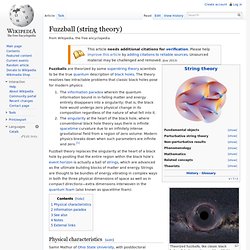
Here, the edge of the central dark spot, the event horizon, delineates not only the threshold where its escape velocity equals the speed of light but also a fuzzball’s physical surface. (Artist rendition) Fuzzballs are theorized by some superstring theory scientists to be the true quantum description of black holes. The theory resolves two intractable problems that classic black holes pose for modern physics: Astronomical object. Above the round domes of La Silla Observatory, three astronomical objects in the Solar System — Jupiter (top), Venus (lower left), and Mercury (lower right).[1] Types of Solar System bodies.
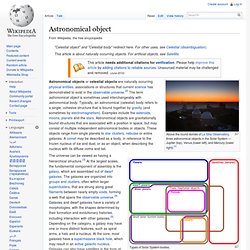
Astronomical objects or celestial objects are naturally occurring physical entities, associations or structures that current science has demonstrated to exist in the observable universe.[2] The term astronomical object is sometimes used interchangeably with astronomical body. Typically, an astronomical (celestial) body refers to a single, cohesive structure that is bound together by gravity (and sometimes by electromagnetism).
Technetium star. A technetium star, or more properly a Tc-rich star, is a star whose stellar spectrum contains absorption lines of the light radioactive metal technetium.
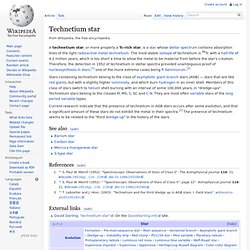
The most stable isotope of technetium is 98Tc with a half-life of 4.2 million years, which is too short a time to allow the metal to be material from before the star's creation. Interstellar nitrogen monohydride. Nitrogen monohydride (NH) is a simple compound that has been detected in interstellar space.

History[edit] One of the earliest papers on the NH molecule was in 1976 by Richard M. Crutcher and William D. Watson. They were still trying to pinpoint the absorption line for NH. Interstellar NH was discovered in outer space for the first time in 1991 by D. Shortly after NH’s discovery, Wagenblast, R.